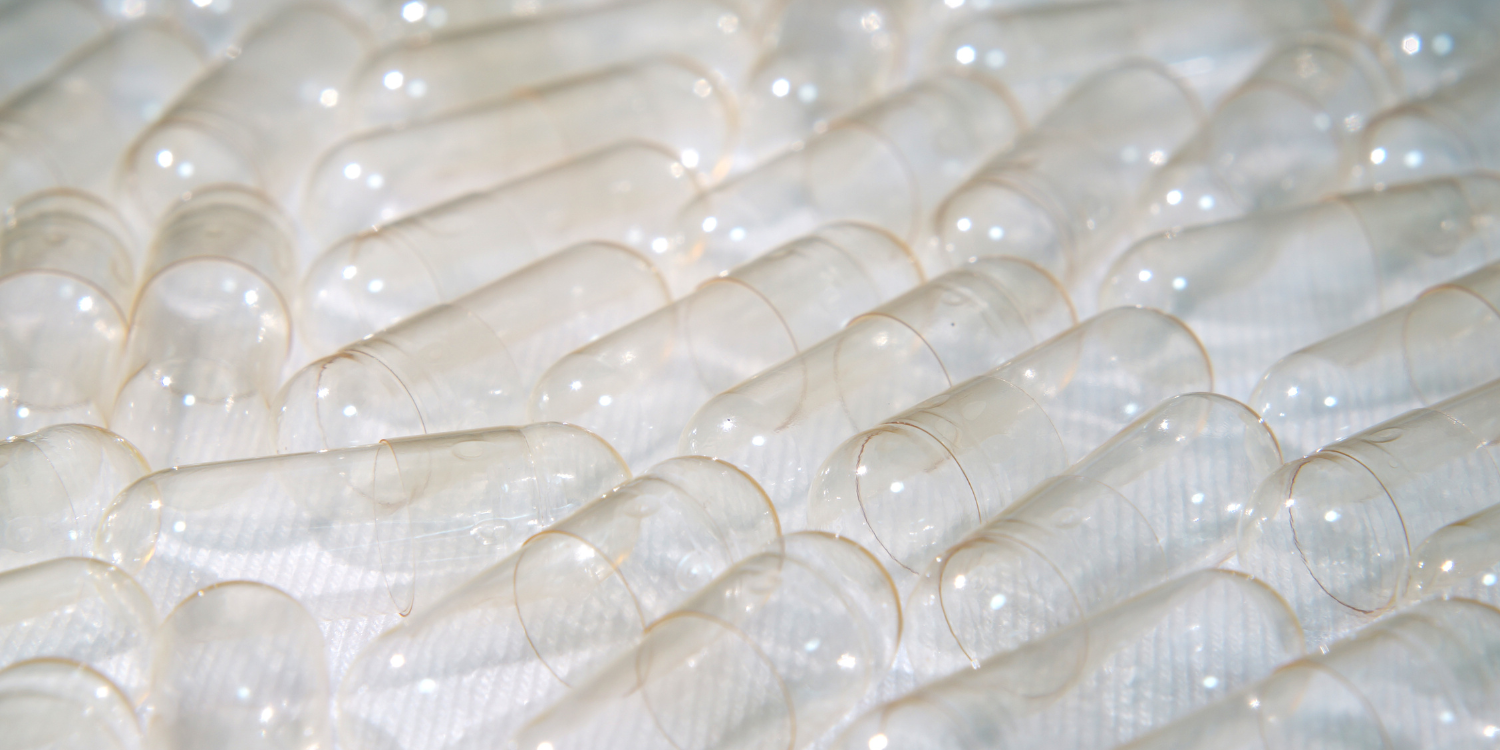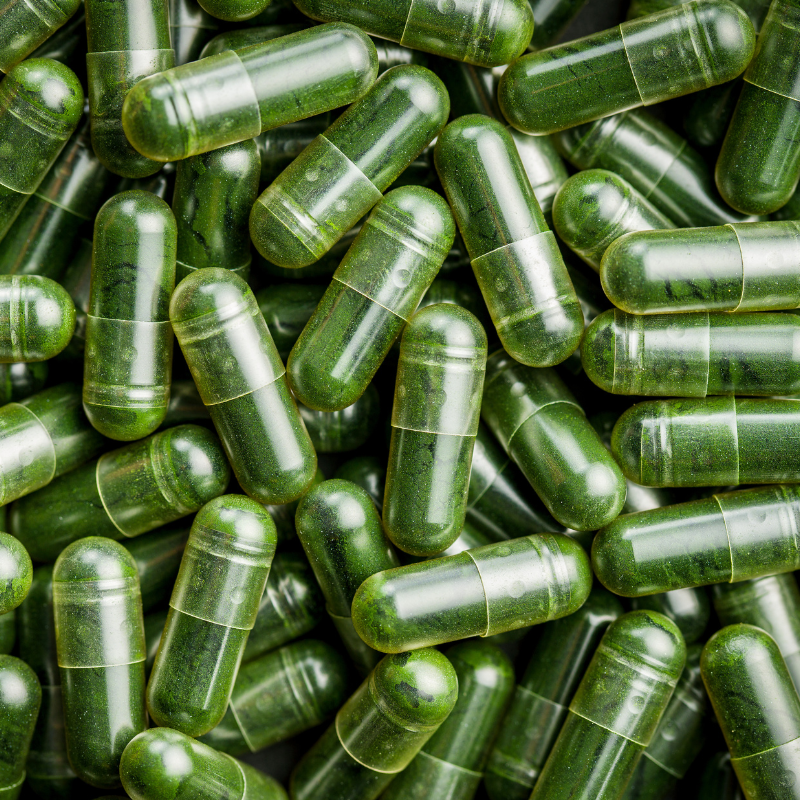
Recent technological advancements and changing demands in the market have significantly impacted the encapsulation of consumable products in the nutraceutical and pharmaceutical industries. For centuries, capsules, particularly gelatin, have been used to protect sensitive ingredients, assist in sustained release of actives, and mask unpleasant flavors of several types of consumables.
Bulk manufacturers, however, are turning toward capsule materials other than gelatin. Hydroxypropyl Methylcellulose (HPMC) capsules, which originates from cellulose fibers, and Pullulan capsules, which comes from a starch made from the fermentation of fungus, are two emerging alternative materials to animal-derived gelatin for several reasons. With consumer preferences for natural and health-conscious products growing while also possessing advantages in product formulation and stability, it is easy to see why plant-based capsules are appealing for consumers and bulk manufacturers alike.
As mentioned above, HPMC stands for Hydroxypropyl Methylcellulose. As a chemically modified cellulose polymer, it is used widely in many products. For example, it is well-known in pharmaceuticals for serving as a thickener and emulsifier. It’s particularly recognized for the controlled release of active ingredients in oral medications and its compatibility with a variety of ingredients and conditions. HPMC is also vegetarian, vegan, and hypoallergenic, catering to diverse dietary needs and preferences.
HPMC capsules are suitable for the bulk manufacturing of products due to several reasons:

HPMC capsules can be a significant asset for bulk manufacturers, offering a comprehensive solution that meets current consumer demands and regulatory standards. For manufacturers aiming for efficiency, quality, and broad market reach in their production, HPMC capsules are an advantageous choice.
Pullulan is a natural polymer produced from starch by the fungus Aureobasidium pullulans. It is biodegradable, edible, and tasteless. In the pharmaceutical and food industries, Pullulan is used for its ability to form strong, oxygen-impermeable films and is often used in the manufacturing products such as food packaging and cosmetics for skin care. It is also another plant-based alternative for gelatin capsules.

There are several advantages to incorporating Pullulan capsules into your production:
Incorporating Pullulan into bulk manufacturing can bring about substantial benefits due to current consumer preferences and market trends. Bulk manufacturers can gain a competitive edge, offering products that are not only high in quality but also resonate with the values and needs of a diverse consumer base, potentially leading to increased consumer loyalty and market share.
When it comes to bulk production, HPMC and Pullulan capsules are excellent alternatives to traditional gelatin capsules, bringing about a new era of manufacturing efficiency and consumer satisfaction. With the global shift towards cleaner, safer, and more sustainable products, HPMC and Pullulan capsules represent a pivotal advancement in capsule technology, delivering both the high performance required by manufacturers and the natural, allergen-free profile desired by today’s health-conscious consumer.

HPMC and Pullulan capsules are increasingly accessible for bulk manufacturing due to their growing popularity and market demand. The renewable and abundant raw materials for both HPMC and Pullulan ensure a steady supply chain, facilitating large-scale production. HPMC capsule supply benefits from a well-established production process, while the burgeoning demand for the Pullulan capsules is being met by an expanding number of suppliers.
The plant-based nature of HPMC and Pullulan capsules provides significant safety and regulatory advantages over animal-sourced gelatin capsules.
Their plant-based composition exempts them from risks associated with animal-derived materials, such as potential transmission of animal-borne diseases like BSE, and allergens. This factor simplifies compliance with strict regulatory standards and facilitates acceptance across diverse global markets.
For bulk manufacturers, the strategic shift to HPMC or Pullulan capsules from traditional gelatin encapsulation is a forward-thinking move that can enhance cost-efficiency and return on investment (ROI). These capsules not only provide excellent product stability and a longer shelf life, which can reduce waste and returns but also open new market segments by meeting the growing consumer demand for vegan and allergen-free products.
Initially, the switch from gelatin to HPMC or Pullulan capsules may involve higher costs due to the need to establish new supply chains and potentially higher per-unit prices for these plant-based materials. However, the financial implications over the long term could be favorable.
Pullulan and HPMC are sourced from renewable plant materials, which can offer more predictable pricing and availability than animal-derived gelatin, which is subject to fluctuations in the meat industry and greater ethical and disease-related risks. This stability can lead to more consistent long-term operational costs.
Moreover, the efficiencies gained from using HPMC and Pullulan — such as lower moisture content leading to better stability and shelf life — can reduce waste and enhance product quality, potentially leading to reduced downtime and higher customer satisfaction with repeat sales. These capsules’ compatibility with a broader consumer base, including those with dietary restrictions, can open up new market opportunities, potentially increasing revenue streams.
Transitioning from gelatin to HPMC or Pullulan capsules in bulk manufacturing involves a careful consideration of initial setup costs and the long-term operational benefits. The switch may necessitate upfront investments such as tweaking existing capsule filling machines for compatibility with the new materials, which typically requires minimal modifications in tooling due to the similar sizes and shapes of the capsules made of different materials. While these initial costs can impact short-term budgets, the long-term operational benefits (including reduced spoilage due to better stability, broader consumer acceptance, and potential for greater market share) promise a favorable return on investment.

The transition from gelatin to HPMC or Pullulan capsules represents a significant shift for bulk manufacturers, one that requires careful navigation to maintain product integrity and production efficiency.
Switching from gelatin to HPMC or Pullulan capsules requires a thoughtful approach to product formulation. Here are some best practices to ensure a seamless transition:
By following these practices, manufacturers can smoothly transition to HPMC or Pullulan capsules, ensuring that their products continue to meet quality standards and consumer expectations.
Supply chain considerations are critical when deciding to manufacture with HPMC or Pullulan capsules. Here are some things to consider when switching from gelatin capsules:
HPMC and Pullulan capsules present a strategic advantage for bulk manufacturers with the progressive shifts in consumer preferences and regulatory landscapes. Their plant-based composition addresses the growing demand for vegan and allergen-free products, while their superior physical properties, such as low moisture content and excellent oxygen barrier, ensure the longevity and efficacy of encapsulated products. For manufacturers, the adaptation to these capsules is not just a response to the evolving industry but a forward-thinking decision that can lead to a competitive edge. By embracing HPMC and Pullulan capsules, manufacturers position themselves at the forefront of innovation, ready to meet the future needs of the health and wellness sectors with agility and confidence.
Ready to elevate your production with high-quality empty capsules? Contact Vivion, your trusted bulk supplier, for all your wholesale capsule and ingredient needs. Take the first step towards a seamless and strategic upgrade to HPMC and Pullulan capsules with Vivion at your side. Reach out today and unlock the full potential of your products!
Sources:
https://www.sciencedirect.com/science/article/abs/pii/B9780323527255000150
https://www.sciencedirect.com/science/article/abs/pii/B9780323428637000116
https://onlinelibrary.wiley.com/doi/pdf/10.1211/0022357055957